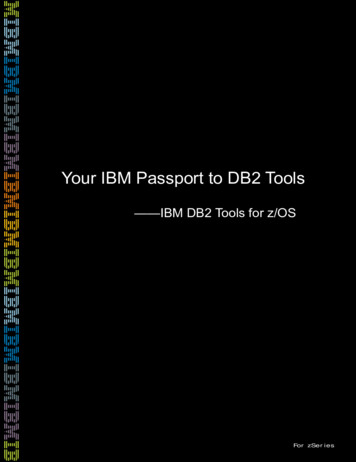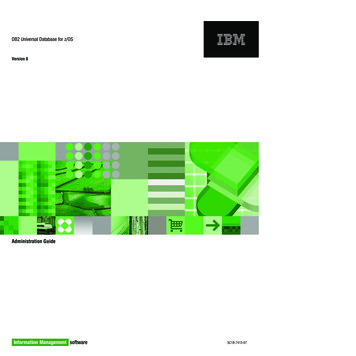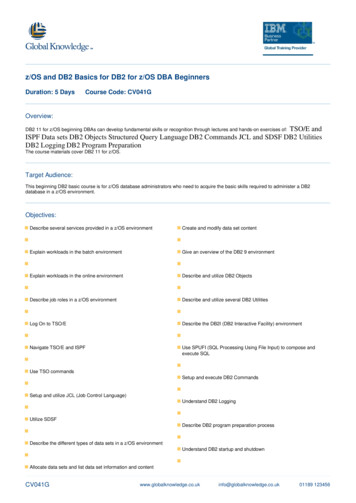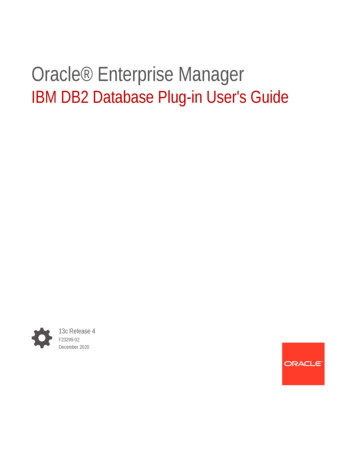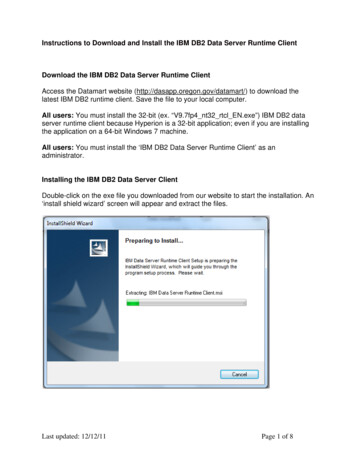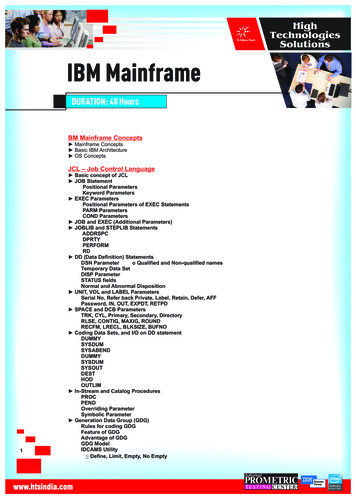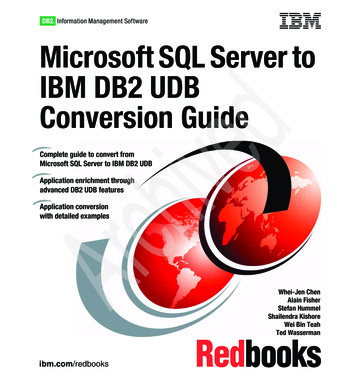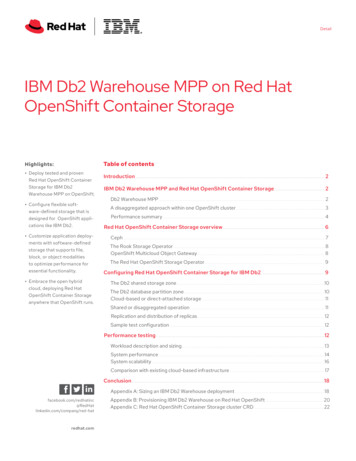
Transcription
DetailIBM Db2 Warehouse MPP on Red HatOpenShift Container StorageTable of contentsHighlights: Deploy tested and provenRed Hat OpenShift ContainerStorage for IBM Db2Warehouse MPP on OpenShift. Configure flexible software-defined storage that isdesigned for OpenShift applications like IBM Db2. Customize application deployments with software-definedstorage that supports file,block, or object modalitiesto optimize performance foressential functionality. Embrace the open hybridcloud, deploying Red HatOpenShift Container Storageanywhere that OpenShift runs.Introduction. 2IBM Db2 Warehouse MPP and Red Hat OpenShift Container Storage. 2Db2 Warehouse MPP.2A disaggregated approach within one OpenShift cluster. 3Performance summary. 4Red Hat OpenShift Container Storage overview. 6Ceph.7The Rook Storage Operator.8OpenShift Multicloud Object Gateway. 8The Red Hat OpenShift Storage Operator. 9Configuring Red Hat OpenShift Container Storage for IBM Db2. 9The Db2 shared storage zone.10The Db2 database partition zone.10Cloud-based or direct-attached storage. 11Shared or disaggregated operation. 11Replication and distribution of replicas.12Sample test configuration.12Performance testing.12Workload description and sizing.13System performance.14System scalability.16Comparison with existing cloud-based infrastructure.17Conclusion.18Appendix A: Sizing an IBM Db2 Warehouse .com/company/red-hatredhat.comAppendix B: Provisioning IBM Db2 Warehouse on Red Hat OpenShift. 20Appendix C: Red Hat OpenShift Container Storage cluster CRD. 22
IntroductionAs organizations move their mission-critical IBM Db2 applications to the hybrid cloud, they needtested and proven solutions that offer scalability, performance, resilience, and security. To aid theseefforts, the IBM Db2 team has spent the last several years transforming its delivery and infrastructure toward a Kubernetes native Db2—tailored for hybrid and multiclouds and managed by OpenShift .Providing an ideal technology combination, Red Hat OpenShift provides thought leadership acrossthe entire stack, delivering a feature set and performance in line with IBM’s requirements for Db2.By redefining the storage layer around Kubernetes-based systems, the community has positionedsoftware-defined storage (SDS) as the de facto storage solution for cloud-based deployments. Inparticular, Red Hat OpenShift Container Storage offers a complete data services platform for appsrunning on Red Hat OpenShift and OpenShift Virtualization. Through this agile, scalable, portable,and highly available platform, storage services can be provisioned and de-provisioned on demand.Container-native storage offers consistent data services so organizations can extract more valuefrom their data—wherever it resides—complementing Red Hat’s strategy of using OpenShift as thesingle control hub for apps and infrastructure life cycle management.IBM and Red Hat engineers have worked closely to ensure that IBM Db2 performs well with Red HatOpenShift and Red Hat OpenShift Container Storage. Two significant initiatives support this approach: An architectural initiative defines the integration and its associated performance, while reviewingprotocols throughout the stack. A practical initiative explores IBM Db2 and Red Hat OpenShift Container Storage deployments,validating scenarios essential to critical database workloads.This paper summarizes IBM Db2 performance on Red Hat OpenShift Container Storage. It providesinsights into the test harness and architectural choices that were made as a part of the process.Finally, it highlights best practices that may be useful to database and storage administrators.IBM Db2 Warehouse MPP and Red Hat OpenShift Container StorageThe sections that follow provide an overview of the architectural approach and a performancesummary for IBM Db2 testing using the Big Data Intelligence (BDI) workload running on Db2Warehouse MPP (Massive Parallel Processing). Based on the test results of Red Hat OpenShiftContainer Storage compared to tests including other software-defined storage options, RedHat OpenShift Container Storage is currently the preferred solution for Db2 Warehouse MPP onOpenShift.Db2 Warehouse MPPIBM Db2 comes with two form factors, both built on the Db2 Common SQL Engine, and aligned withthe latest version: IBM Db2 is best suited for on-line transaction processing workloads, with a strong focus on transaction volume. IBM Db2 Warehouse is best suited for on-line analytical processing (OLAP) workloads, with astrong emphasis on data volume and query performance.redhat.comDetail IBM Db2 Warehouse MPP on Red Hat OpenShift Container Storage2
An OLAP workload was chosen for testing—due to the demanding nature of the workload and thedesire to provide a cross-sectional view of full-stack performance. As such, the Db2 Warehouse formfactor was appropriately selected. Db2 Warehouse can be deployed in either a single-node (SMP) ormulti-node deployment designed for massively parallelized processing (MPP). In MPP deployments,Db2 Warehouse segments a query into smaller tasks that are then spread across multiple databasepartitions (Figure 1). Db2 is also able to coordinate multiple cores per Db2 process at scale. An MPPdeployment has a minimum of three nodes and a maximum of either 24 or 60 nodes (depending ondatabase kDatabase partitionDatabase partitionDatabase partitionDatabase partitionFigure 1. Db2 Warehouse MPP segments queries across multiple isolated database partitions.A disaggregated approach within one OpenShift clusterFor this workload, IBM and Red Hat employed a disaggregated configuration where Db2 on OpenShiftand Red Hat OpenShift Container Storage ran on physically separate nodes (Figure 2). Isolatingcompute from storage in this fashion provides advantages, including: The underlying capabilities of the worker nodes could be optimized for the respective workload.For example, memory- or CPU-intensive compute nodes could be configured as compared to storage-intensive nodes. Moreover, a disaggregated approach allows compute (or database) services to be convenientlyscaled independently from storage services.1 JDQ/com.ibm.swg.im.dashdb.doc/admin/local prereqs.htmlredhat.comDetail IBM Db2 Warehouse MPP on Red Hat OpenShift Container Storage3
Worker(Db2)Worker(Db2)Worker(Db2)Worker(Db2)Db2 podMLN 0Db2 podMLN 1Db2 podMLN 2Db2 podMLN 3ApplicationInstance type:r5a.4xlarge(16 vCPU,128GB RAM)MasterInstance NVMe NVMeNVMe NVMeNVMe NVMeStorageInstance type:i3en.2xlarge(8 vCPU,64GB RAM,2x 2.3TB NVMe)Figure 2. Testing took place on a disaggregated eight-node cluster.Note: More information on the cluster configuration is provided in the section onperformance testing.Performance summaryBig Data Intelligence (BDI) is an IBM-defined workload that models a day in the life of a BusinessIntelligence application. The workload is based on a retail database with in-store, on-line, and catalogsales of merchandise. Three types of users are represented in the workload, running three typesof queries: Returns dashboard analysts generate queries that investigate the rates of return and impact on thebusiness bottom line Sales report analysts generate sales reports to understand the profitability of the enterprise Deep-dive analysts (data scientists) run analytics to answer questions identified by the returnsdashboard and sales report analystsThe database can be generated at any scale factor. IBM testing included two databases, representing: A 1TB workload A 2TB workloadSeveral suites of tests were then run using the 1TB and 2TB workloads: Serial warmup runs (running all 100 queries end-to-end) Serial runs of three iterations (running through all 100 queries in serial mode)redhat.comDetail IBM Db2 Warehouse MPP on Red Hat OpenShift Container Storage4
16 concurrent heavy users running as many intermediate and complex queries as possible forone hour 32 concurrent heavy users running as many intermediate and complex queries as possible forone hourThe testing proved that Red Hat OpenShift Container Storage performs well at scale for productionDb2 Warehouse MPP workloads running on OpenShift container clusters. For the 1TB workload, thetests ran mostly in memory. After doubling the workload to 2TB, performance only dropped by 44%demonstrating the scalability of the platform (Figure 3).600Throughput 6 users32 users228.892TB16 users32 usersFigure 3. Performance scaled well, dropping by only 44% when doubling the workload size.During testing, the cluster was instrumented to understand utilization and scalability. Results werethen compared to other cloud-based configurations for Db2. Resource utilization. Testing showed that CPU, memory, disk, and network resources were all utilized very effectively during both the 1TB and 2TB runs. CPU and disk utilization showed availableheadroom on a per-system basis, and memory and Network I/O utilization rates were consistentacross all four Db2 nodes and all three Red Hat OpenShift Container Storage nodes. System scalability. Utilization rates increased when moving from the 1TB to the 2TB workloads,demonstrating good system scalability to handle the larger workload. Higher CPU and disk utilization with the 2TB workloads indicate that system resources were used effectively. For most tests,runtime increased symmetrically with data volume. For the multi-user runs, a 2x increase in datasize caused only a 1.75x reduction in throughput.redhat.comDetail IBM Db2 Warehouse MPP on Red Hat OpenShift Container Storage5
Performance comparison. In order to better characterize the performance of Db2 Warehouserunning on Red Hat OpenShift Container Storage, results were compared to tests performed withother cloud-based storage configurations for Db2, taken over the last two years. As some olderresults were not directly comparable, the results of the 1TB runs were compared and normalizedwith those of different cloud storage configurations. This comparison demonstrated that Db2running on Red Hat OpenShift Container Storage performs very well compared to other softwaredefined storage approaches.Red Hat OpenShift Container Storage overviewRed Hat OpenShift Container Storage offers the preferred persistent storage for cloud-nativeapplications like Db2 running in OpenShift. Application teams can dynamically provision persistentvolumes (PVs) for a wide variety of workload categories. The platform offers: Agility to streamline app/dev workflows across the hybrid cloud. Scale to support emerging data-intensive workloads for Kubernetes customers. Portability to provide data placement and access across clouds.As Kubernetes has emerged and grown as the vehicle of modern development, complex stateful workloads like Db2 have driven the need for persistent container-native storage. OpenShiftContainer Storage is designed and built to supply all the needs of modern stateful applications in theKubernetes domain, offering advantages that include: Platform agnostic, supporting cloud, bare-metal, and virtualized environments Open source, based on Ceph, Rook, and NooBaa Simple to install, update, and use Scalable Resilient Performant Support for block, object and file storage in a single productOne of the key features of OpenShift Container Storage is its simplicity and ease of installation stemming from the Kubernetes orchestration framework and the use of operators. Operators are customsoftware extensions to Kubernetes that make use of custom resources to automate and manageapplications and their components. The Red Hat OpenShift Container Storage operator is a singlemeta-operator, providing one interface for installation and management for three components: Ceph. Red Hat Ceph Storage is the central storage building block providing the storage servicesdata plane inside Red Hat OpenShift Container Storage. Rook. Rook is the Kubernetes operator for Ceph, automating many Ceph deployment, operations,and upgrade tasks. NooBaa. The OpenShift Multicloud Object Gateway (MCG) is an object data service based onNooBaa technology that delivers policy-based data placement across hybrid and multicloudenvironments.redhat.comDetail IBM Db2 Warehouse MPP on Red Hat OpenShift Container Storage6
CephSince its inception in 2007, Ceph has become one of the leading software-defined storage (SDS)solutions with clusters running on large production environments that can consist of hundreds ofnodes. As an elastic storage services infrastructure, Ceph allows you to scale up with bigger/fasterhardware and scale out for capacity and performance. Ceph also enables the federation of multipleclusters across sites with asynchronous replication and disaster recovery capabilities.As a contributor to the upstream Ceph project, Red Hat ensures that features are ready for enterpriseworkloads and incorporates them into Red Hat Ceph Storage. As the foundational storage technologyinside Red Hat OpenShift Container Storage, Red Hat Ceph Storage provides a robust and compelling data storage solution that can support all of your data, no matter the format or origin. A self-healing, self-managing platform with no single point of failure, Red Hat Ceph Storage can significantlylower the cost of storing enterprise data and help companies manage exponential data growth in anautomated fashion.Ceph is based on the Reliable Autonomic Distributed Object Store (RADOS, Figure 4). Unlike storagethat only supports a single consumption mechanism, Red Hat Ceph Storage offers support for multiple storage modalities, including: Block storage via the RADOS Block Device (RBD). Object storage via the RADOS Gateway (RGW). File storage via CephFS.OBJECTBLOCKFILERGWRBDCEPHFSS3 and Swiftobject storageS3 and Swiftobject storageDistributed networkfile systemLibradosLow-level storage APIRadosReliable, elastic, distributed storage layer withreplication and erasure codingFigure 4. Ceph high-level block diagram.From an architectural perspective, Ceph provides software modules that are designed for differenttasks and responsibilities, including: Object Storage Daemons (OSDs). OSDs consume a storage device (e.g., a local drive, a partition, a SAN LUN, or a cloud provider volume) and map the device as part of a larger group of otherOSDs to provide continuous storage to be used by applications.redhat.comDetail IBM Db2 Warehouse MPP on Red Hat OpenShift Container Storage7
Monitoring servers (MONs). The MONs create the interface to the actual storage used by applications. MONs contain the current active Ceph cluster map. The MONs hold a list of OSDs and alist of MONs, distributing the load between the clients while assuring that specific quorum rulesexist to make sure of data availability and accessibility. Metadata servers (MDS). The MDS maintains information about placement groups (PGs, amethod to manage millions of storage objects efficiently) and also information on the metadata/host processes. The MDS adds POSIX metadata to objects so they can be consumed as filesthrough a distributed file system (CephFS). The MDS also provides a RESTful API to monitor thecluster.With Red Hat Ceph Storage inside, Red Hat OpenShift Container Storage users enjoy all the featuresof an integrated cloud-native persistent storage solution, while benefiting from the robust pedigreeof an enterprise proven data services platform.The Rook storage operatorRook is a Kubernetes Operator designed to facilitate Kubernetes management of storage. It is anopen source (Apache 2.0) Cloud Native Computing Foundation (CNCF) hosted project and includescode for several storage providers/consumers, including Ceph, Cassandra, CockroachDB, theNetwork File System (NFS), and EdgeFS. Ceph and EdgeFS are the most active providers in the Rookproject.To manage and automate storage, Rook follows the Kubernetes operator patterns that include: Automating processes that humans would typically perform. Observing and discovering the current state of the cluster. Analyzing and determining if any differences from the desired state exist, and performing operations to get to the desired state.Rook uses Custom Resource Definitions (CRDs) to manage the storage provider, allowing automateddeployment, configuration, provisioning, scaling, upgrading, and resource management of storagein the Kubernetes cluster. This approach retains Ceph principles so that Ceph components (OSDs,MONs, MDS, and RGW) are delivered in pods within the Kubernetes cluster.OpenShift Multicloud Object GatewayThe OpenShift Multicloud Object Gateway (based on the NooBaa open source project) allows singlescalable storage access to object storage. Using the Amazon Simple Storage Service (S3) API,OpenShift Multicloud Object Gateway lets you control the number of bucket copies and where toplace the copies (on-prem, VM, or cloud provider) based cost considerations or security. For example,the technology supports: Multicloud buckets Hybrid buckets Multisite bucketsredhat.comDetail IBM Db2 Warehouse MPP on Red Hat OpenShift Container Storage8
In Red Hat OpenShift Container Storage, the OpenShift Multicloud Object Gateway keeps a copy ofthe bucket in Red Hat Ceph Storage, but you can easily add other locations. The NooBaa KubernetesOperator manages deployment and second-day operations, while the NooBaa core pod manages thedata flow and provides the object as a service.The Red Hat OpenShift Storage OperatorThe Red Hat OpenShift Storage Operator provides the management and organization layer for thecore components mentioned previously, including Ceph, Rook, and NooBaa (Figure 5). The operator allows you to install all three components at once. It acts as one place to control and monitor allstorage layers as well as the layout of Red Hat OpenShift Container Storage core components. It alsofacilitates day-two management operations, such as coordinating software updates for each of theinstalled components.AppAppVolume claimVolume claimBlockAppAppObjectbucket claimFileObjectRed Hat OpenShift Container Storage DOSDOSDOSDOSDFigure 5. The Red Hat OpenShift Storage Operator provides a management and organization layer for all includedsoftware components.Configuring Red Hat OpenShift Container Storage for IBM Db2Db2 database architecture dictates how software-defined storage must be configured in anOpenShift context. While Db2 on OpenShift deployments support some storage variations, thecorrect configuration needs to be provisioned upfront to avoid outages later in the process. By supporting both file and block storage, Red Hat OpenShift Container Storage provides key flexibility thatallows you to fine-tune storage configurations for the specific needs of Db2.Db2 Warehouse represents a shared-nothing database architecture, in which database partitionsare fully isolated from each other—visible only to a single Db2 pod in a topology of many. At the sametime, some minimal information needs to be shared across the entire Db2 deployment. For instance,while partition data can be entirely local to achieve the fastest input/out (I/O) rates, the Db2 instancedirectory is a core installation requirement that needs to be shared across multiple pods. As such, twostorage zones are required to achieve optimal Db2 performance (Figure 6):redhat.comDetail IBM Db2 Warehouse MPP on Red Hat OpenShift Container Storage9
A shared storage zone (RWX access pattern) for when multiple Db2 pods need to read and write toa storage area from within the entire Db2 ecosystem. A dedicated storage zone (RWO access pattern) for each database partition in an individual pod toread and write to a storage area.DB2 Warehouse MPPDb2 ecosystemDb2 coreDb2 Database EngineDb2 jobsDb2 Database EngineDb2 Database EngineDb2 Database ata0RWXRWORWXRWORWXRWORWXRWODb2 LDAP serviceDb2 UI consoleDb2 RESTDb2 toolsRead-write frommultiple podsRead-write fromsingle podFigure 6. Db2 requires both dedicated (RWO access pattern) and shared (RWX access pattern) storage.With Red Hat OpenShift Container Storage, both the type of storage (e.g., file or block) and thestorage technology itself (e.g., cloud-based storage volumes or direct-attached storage) can be configured appropriately to match workload needs.The Db2 shared storage zoneThe Db2 shared storage zone has low I/O operations per second (IOPS). As such, this zone can bebacked by file-type storage within Red Hat OpenShift Container Storage, yielding performancetypical of network-attached storage (NAS) solutions. Db2 will use this storage space to host the following data: Db2 instance home directory Database manager configurations Db2 error messages file Db2 installation path Deployment metadata such as the key-value topology stored by each Db2 podThe Db2 database partition zoneIn contrast, the Db2 database partition storage zone has very high IOPS requirements and stringentperformance expectations. In this implementation, this storage zone is backed by block-type storagewithin Red Hat OpenShift Container Storage, similar in performance profile to a storage area network(SAN). Storage for the database partition zone needs to be able to store: Storage path information Table space information Dataredhat.comDetail IBM Db2 Warehouse MPP on Red Hat OpenShift Container Storage10
Indexes Configuration files Transaction logs Database configuration filesCloud-based or direct-attached storageIn a Ceph cluster, an OSD process represents a storage device that it can use to build the storagecluster. In Red Hat OpenShift Container Storage, however, an OSD is represented as a pod. For thatpod to use a storage device, it needs a persistent volume (PV) and a persistent volume claim (PVC)for that volume. When designing an OpenShift cluster together with Red Hat OpenShift ContainerStorage, the type of the PV used for the OSD pods will determine or impact some of the storagecharacterizations.In the cloud, you have the choice of storage options to use as the building block for Red HatOpenShift Container Storage. You can use a portable volume provided by the cloud provider, suchas an Amazon Elastic Block Storage (EBS) volume. You can also use direct-attached storage that isconnected directly to the cloud-provider instance. When using the portable volume option (e.g., thedefault Amazon GP2 EBS volume), the volume is transferable between instances on the same availability zone. If an OSD pod fails, a new OSD pod can start quickly on the same or different instancein the cloud using the same data storage volume (i.e., the very same PV). This ability can significantlyreduce the recovery point objective (RPO), since the Red Hat Ceph Storage data is still available tothe new pod, with only some minor roll-forwards needed to get back to three full working replicas.The disadvantages of using a cloud-provided volume include both performance and price. The performance capabilities of the volume usually derive from the size of the volume, with a larger volumeequating to more IOPS. In general, the performance of these volumes is slower than regular storagedevices such as a solid-state drive (SSD) directly connected to a server.Another option for Red Hat OpenShift Container Storage is to use direct-attached storage, as isavailable with an AWS i3en instance. In this scenario, a storage device is directly connected to theinstance running Red Hat OpenShift Container Storage. As mentioned, the performance can be significantly better for most use cases, even while the total storage price is less. When running on baremetal clusters, using direct-attached storage devices is preferable. The beauty of Red Hat OpenShiftContainer Storage is that all of these options are just PVs that the OSDs will use to create the Cephcluster—whether you use a volume from a cloud provider or a direct-attached storage device. Thistransparency helps accelerate hybrid cloud adoption.Shared or disaggregated operationAs discussed, another important consideration is whether the OpenShift worker nodes will shareresources with Red Hat OpenShift Container Storage or not. A truly shared solution—where eachworker node both provides and consumes storage—is native to the Red Hat OpenShift ContainerStorage architecture. However, Kubernetes must have enough resources to run all the neededOpenShift container pods.Another option is to run Red Hat OpenShift Container Storage services on their own OpenShift infrastructure nodes. In this disaggregated option, a set of OpenShift infrastructure (infra) nodes runsonly OpenShift and Red Hat OpenShift Container Storage services. The rest of the worker nodes arereserved for the applications running on the cluster (Db2 in our case).redhat.comDetail IBM Db2 Warehouse MPP on Red Hat OpenShift Container Storage11
Choosing this disaggregated cluster approach allows you to optimize performance by selecting different types of nodes for storage services compared to those used for the rest of the applicationsrunning on the OpenShift cluster. Disaggregated operation also allows you to scale compute (app) orstorage services (Red Hat OpenShift Container Storage) independently from each other.Replication and distribution of replicasRed Hat OpenShift Container Storage provides resiliency through Ceph replication. The currentrelease employs a replication factor of three (3x), which implies that three copies of your data aredistributed across all the available OSDs in the cluster. With Red Hat OpenShift Container Storage,you can specify the rules that determine how you want the copies distributed. For example, you couldplace a copy of your data in separate racks in an on-prem cluster, or within different Availability Zonesin a cloud deployment.Sample test configurationAs described, the testing described in this paper ran on AWS using Red Hat OpenShift ContainerStorage in a disaggregated configuration. Storage providers (Red Hat OpenShift Container Storage services) were built on three AWSi3en.2xlarge instances running as OpenShift infra nodes, each with two 2.3TB NVMe directlyattached to the instance. Storage consumers (Db2 instances) were supported on four AWS r5a.4xlarge instances running theDb2 Warehouse MPP pods.This configuration (with 3x replication) provided 4.6TB of available storage for Db2 Warehouse MPP,divided between RWO PVCs (Ceph RBD/block) and RWX PVCs (CephFS). The MON pods consumedvery little storage and used a 10GB EBS GP2 volume for each pod. To allow direct-attached storageto be consumed by the OSD pods, the Local Storage Operator (LSO) was used to create local PVsmatching each of the NVMe devices on
Storage for IBM Db2 Warehouse MPP on OpenShift. Configure flexible soft - ware-defined storage that is designed for OpenShift appli - cations like IBM Db2. Customize application deploy - ments with software-defined storage that supports file, block, or object modalities to optimize performance for essential functionality.
